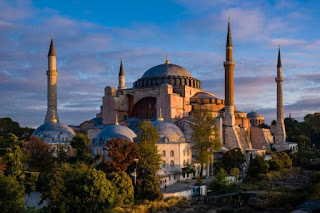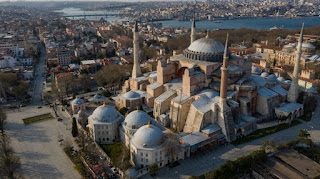Hagia Sophia
History of Hagia Sophia :
Hagia Sophia, also known as Ayasofya in Turkish, is a historic architectural marvel located in Istanbul, Turkey. It has played a significant role in religious, cultural, and architectural history for over a millennium. Here's an overview of its history:
Byzantine Period:
- The original Hagia Sophia was built by the Roman Emperor Constantius II in 360 AD on the same site as an earlier church that was destroyed during riots.
- The first Hagia Sophia was a basilica-style church with a wooden roof and relatively modest appearance compared to its later iterations.
The Great Church:
- Emperor Justinian I commissioned the construction of the grand Hagia Sophia that stands today after the earlier versions were damaged by fires and revolts.
- Completed in 537 AD, the new Hagia Sophia was an architectural marvel, known for its massive dome, intricate mosaics, and innovative design elements.
- The dome's construction posed engineering challenges, but it was successfully accomplished using innovative architectural techniques.
Byzantine Church and Cathedral :
- For nearly a thousand years, Hagia Sophia served as the main cathedral of the Eastern Orthodox Church and the spiritual center of the Byzantine Empire.
- The church was known for its magnificent interior mosaics depicting religious scenes and figures.
Ottoman Era :
- In 1453, Constantinople (modern-day Istanbul) was conquered by the Ottoman Empire under Sultan Mehmed II, and Hagia Sophia was converted into a mosque.
- Minarets were added to the structure, and Islamic elements were integrated into the building's design.
Modern Era :
- In 1935, under the rule of Mustafa Kemal Atatürk, the founder of modern Turkey, Hagia Sophia was secularized and turned into a museum as part of his efforts to modernize the country.
- The interior mosaics, which had been covered or plastered over during the Ottoman period, were gradually uncovered and restored.
Reconversion to a Mosque:
- In July 2020, the Turkish government decided to convert Hagia Sophia back into a mosque. This decision sparked international debates and discussions about its historical and cultural significance.
UNESCO World Heritage Site:
- Hagia Sophia has been recognized as a UNESCO World Heritage Site since 1985 for its outstanding historical and architectural value.
Architectural Influence:
- Hagia Sophia's innovative architectural elements, including its massive dome, pendentives, and elegant proportions, have had a lasting influence on later Byzantine, Ottoman, and other architectural styles.
- Hagia Sophia's rich history as a religious site, architectural wonder, and symbol of cultural and historical transitions reflects its enduring significance to both the people of Turkey and the global community.
Facts about Hagia Sophia:
Impressive Dome:
The massive central dome of Hagia Sophia was an engineering marvel of its time. It measures about 32 meters (105 feet) in diameter and rises to a height of approximately 55.6 meters (182 feet).
Innovative Design:
Hagia Sophia's design inspired later architects in the Byzantine, Ottoman, and even Renaissance periods. Its dome and pendentives allowed for a more open and spacious interior, influencing the development of architectural techniques.
Mosaics:
The interior of Hagia Sophia was adorned with intricate mosaics depicting religious figures, events, and scenes. Many of these mosaics were covered or altered during the Ottoman era but have been gradually uncovered and restored.
Unique Ablution Fountain:
Hagia Sophia features a unique ablution fountain or "şadırvan" in its courtyard. This element, traditionally seen in mosque courtyards, reflects the building's transition from a church to a mosque.
Calligraphy:
After its conversion into a mosque, Hagia Sophia was decorated with Islamic calligraphy, including Quranic verses and the names of Allah, the Prophet Muhammad, and other religious figures.
Minarets:
Ottoman architects added four minarets to Hagia Sophia during the mosque conversion. These minarets are characteristic of Islamic architecture and serve as distinct visual features.
Attractions of Hagia Sophia:
Dome and Interior:
The awe-inspiring dome is a major attraction. The interior features a spacious nave, intricate mosaics, and marble decorations that reflect both Byzantine and Ottoman influences.
Mosaics and Frescoes:
Visitors can see a collection of mosaics and frescoes, including the famous mosaic of the Virgin and Child (Deesis) and the Comnenus mosaic. These artworks provide insights into the historical and religious context of the building.
Ottoman Elements:
The mihrab (prayer niche) and minbar (pulpit) are notable Ottoman additions to the mosque's interior. They showcase Islamic architectural and decorative styles.
Tombs:
Hagia Sophia contains the tombs of various Ottoman sultans and their family members. The most prominent is the tomb of Sultan Mehmed the Conqueror.
Cultural Significance:
Symbol of Transition:
Hagia Sophia's transformation from a cathedral to a mosque to a museum and back to a mosque reflects the historical and cultural shifts of Istanbul and Turkey. It represents the interplay between different eras and identities.
Interfaith History:
As a former church and current mosque, Hagia Sophia embodies the coexistence of Christianity and Islam, showcasing how historical buildings can carry the stories of multiple religious and cultural identities.
Tourist Destination:
Regardless of its role, Hagia Sophia has remained a popular tourist attraction, drawing millions of visitors each year who come to admire its architectural grandeur and historical significance.
Hagia Sophia's layered history, architectural splendor, and cultural symbolism make it a must-visit site for those interested in exploring the intersections of faith, architecture, and history. It stands as a testament to the enduring power of human creativity and the dynamic nature of cultural heritage.





0 Comments